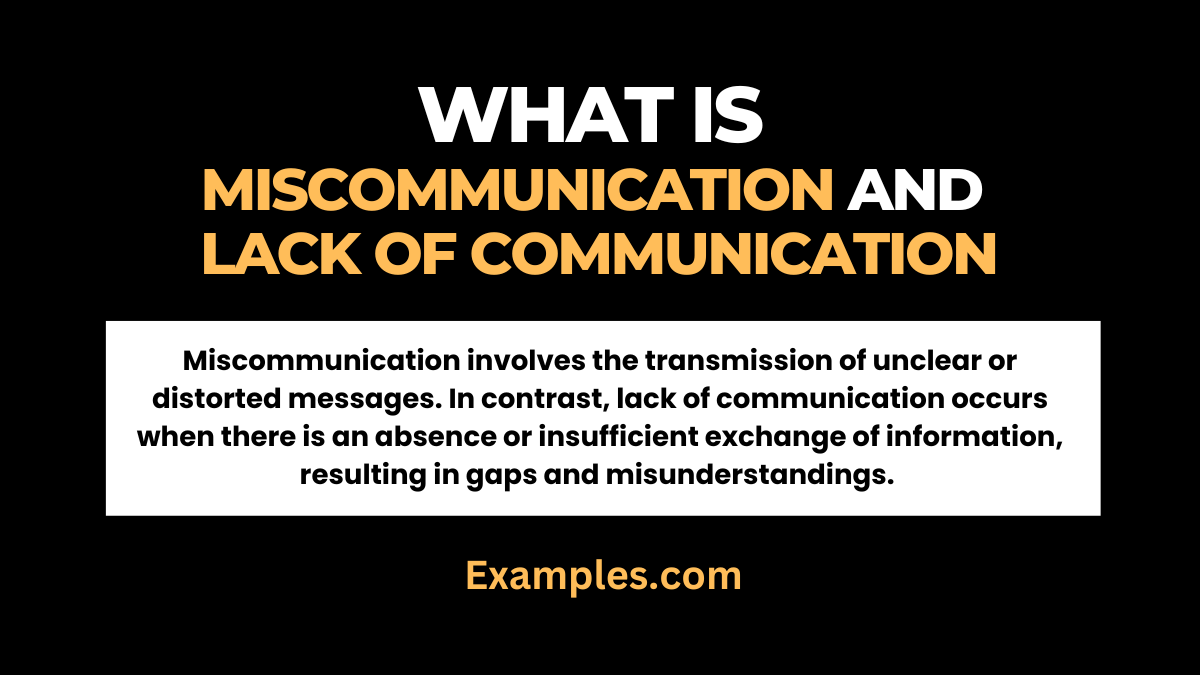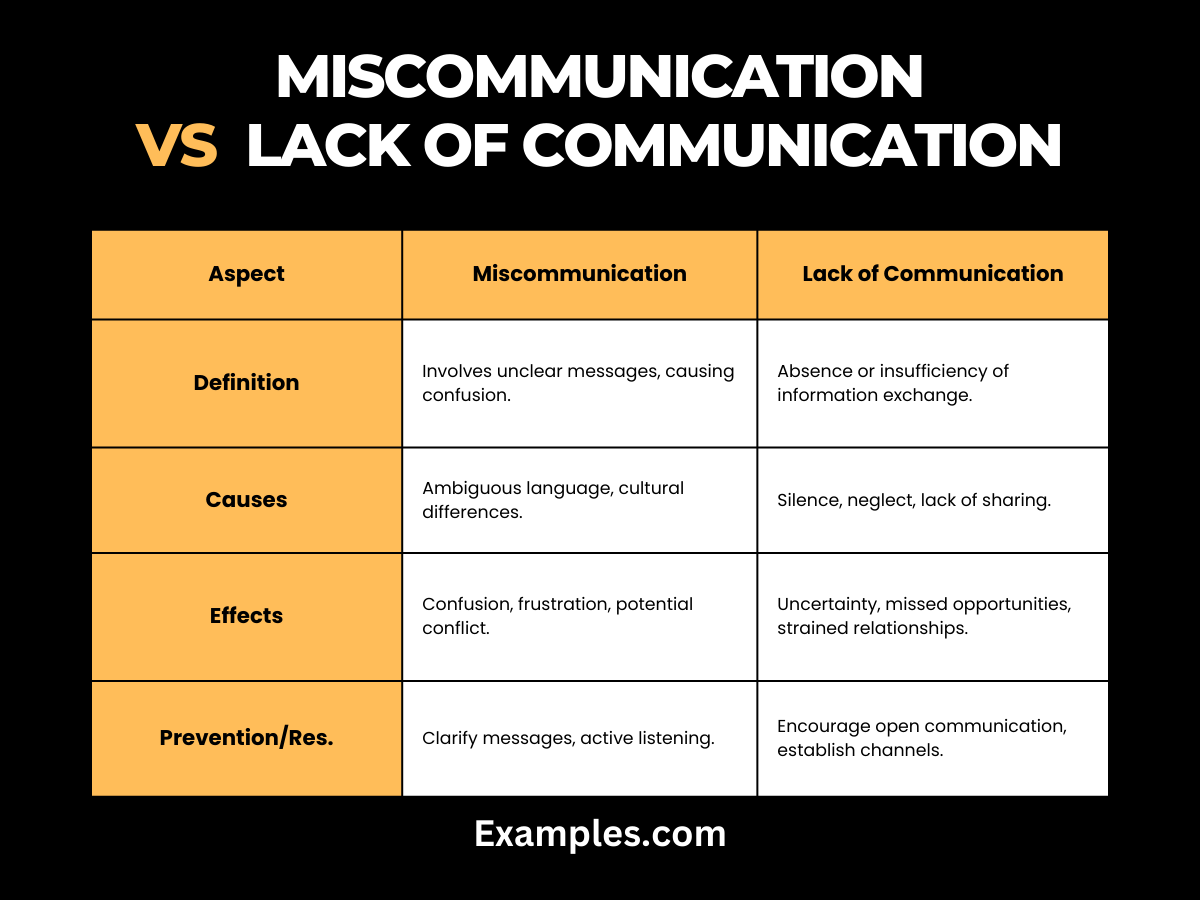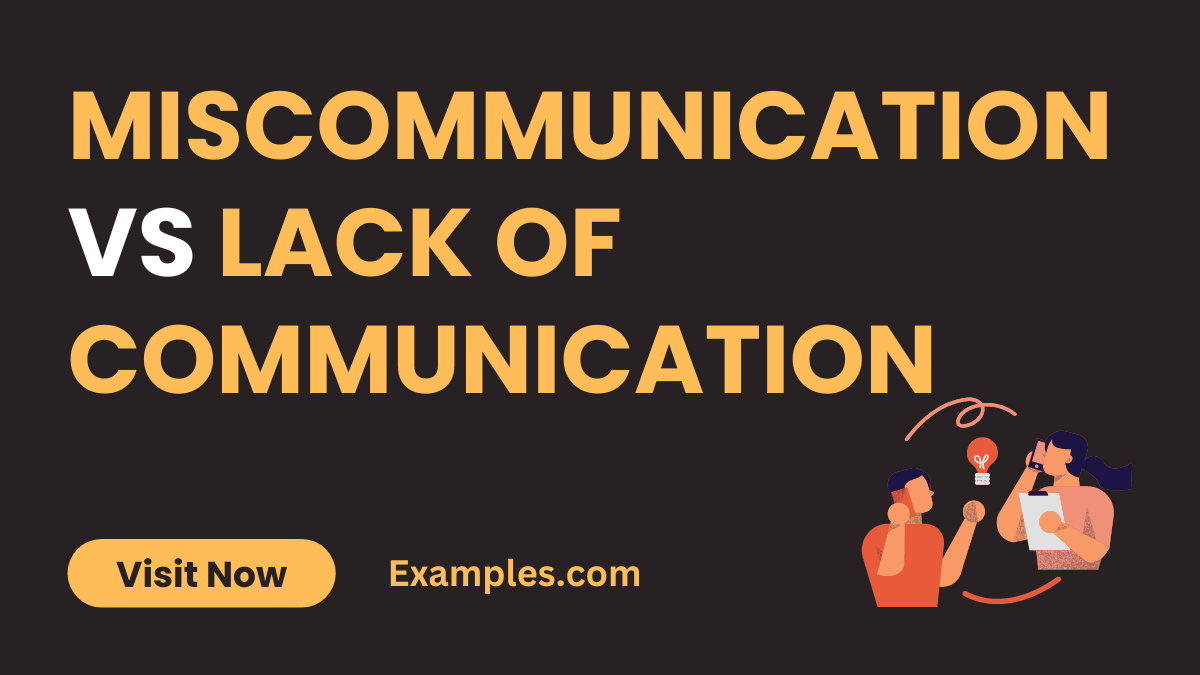Miscommunication vs Lack of Communication
Unlock the secrets of effective communication by delving into the comprehensive guide on Miscommunication vs Lack of Communication. Explore real-world Communication Examples that illuminate the differences, providing valuable insights. Enhance your communication skills and gain the expertise needed for seamless interactions in various contexts. Discover practical tips to bridge the gaps and ensure clarity, fostering better connections.
What is Miscommunication and Lack of Communication

Miscommunication involves the transmission of unclear or distorted messages, leading to confusion or misinterpretation. In contrast, lack of communication occurs when there is an absence or insufficient exchange of information, resulting in gaps and misunderstandings. Understanding these nuances is crucial for fostering effective interpersonal and organizational communication.
Difference Between Miscommunication And Lack of Communication
Explore the nuanced distinctions between Miscommunication and Lack of Communication through this comprehensive table. Understanding these differences is vital for effective interpersonal dynamics.

| Aspect | Miscommunication | Lack of Communication |
|---|---|---|
| Definition | Involves unclear or distorted messages, leading to confusion or misinterpretation. Miscommunication can occur due to ambiguous language, poor delivery, noise in communication channels, cultural differences, and misinterpreted nonverbal cues. | Refers to the absence or insufficiency of information exchange, hindering understanding. Lack of Communication may stem from silence, neglect, insufficient sharing, or a lack of avenues for communication. |
| Causes | Ambiguous language, poor delivery, noise, cultural differences, misinterpreted cues. Miscommunication can arise when the sender’s message is unclear or distorted, leading to confusion and misinterpretation. This can be caused by using ambiguous language, delivering the message poorly, external noise in communication channels, cultural differences, and misinterpreting nonverbal cues. | Silence, neglect, insufficient sharing, lack of avenues for communication. Lack of Communication can occur when there is a lack of verbal or nonverbal exchange of information. This may result from silence, neglect, insufficient sharing of information, or a lack of effective channels for communication within a group or organization. |
| Effects | Confusion, frustration, potential conflict, breakdown in communication. Miscommunication can have various effects, including confusion, frustration, potential conflicts, and a breakdown in communication. When messages are unclear or distorted, it can lead to misunderstandings and hinder effective communication. | Uncertainty, uninformed decisions, missed opportunities, strained relationships. Lack of Communication can result in uncertainty, uninformed decisions, missed opportunities, and strained relationships. When there is a lack of information exchange, individuals may feel uninformed, and decisions may be made without complete understanding. |
| Prevention/Resolution | Clarify messages, use precise language, active listening, awareness of nuances. To prevent and resolve Miscommunication, it’s essential to clarify messages, use precise language, practice active listening, establish feedback loops, and be aware of cultural nuances. | Encourage open communication, establish channels, share information consistently. To prevent and address Lack of Communication, it’s crucial to encourage open communication, establish effective channels for communication, and ensure consistent sharing of information. Creating an environment that fosters communication is essential. |
| Examples | Email with unclear instructions, ambiguous project guidelines, misinterpreted cues. Examples of Miscommunication include receiving an email with unclear instructions, encountering ambiguous project guidelines leading to errors, and misinterpreting nonverbal cues in a cross-cultural setting. | Lack of project updates, unaddressed concerns, absence of regular team meetings. Examples of Lack of Communication include a lack of project updates, unaddressed concerns within a team, and the absence of regular team meetings, leading to uninformed team members and missed opportunities for collaboration. |
Comparison Between Miscommunication And Lack of Communication
When delving into the intricacies of communication challenges, it’s essential to discern the shared aspects between miscommunication and lack of communication.
- Impact on Relationships: Both miscommunication and lack of communication can strain relationships. Whether through confusion caused by misinterpretation or the absence of information exchange, the relational repercussions are notable.
- Potential for Conflict: The shared consequence of miscommunication and lack of communication is the potential for conflict. Incomplete or unclear messages can lead to misunderstandings, while silence or neglect can result in unaddressed concerns escalating into conflicts.
- Operational Disruptions: Organizations can experience operational disruptions due to either miscommunication or lack of communication. Incomplete information or a failure to convey crucial details can impede workflow and project success.
Resolution Strategies:
- Open Communication Cultivation: Both scenarios benefit from fostering open communication. Encouraging team members to express themselves and share information proactively addresses the root causes of miscommunication and prevents the void created by lack of communication.
- Clarity Promotion: Promoting clarity in communication is a shared resolution strategy. Whether rectifying misunderstood messages or filling the gaps left by silence, emphasizing the importance of clear and concise communication mitigates challenges.
Relation between miscommunication and lack of communication
Miscommunication and lack of communication are intricately connected in the tapestry of interpersonal dynamics. Understanding the interplay between these two aspects is crucial for fostering effective interactions.
- Shared Foundations: Miscommunication often arises when there is a lack of clear communication. The foundation of effective interaction is built upon clarity, and when this foundation is weak, misunderstandings and misinterpretations can flourish.
- Communication Breakdown: Lack of communication serves as a fertile ground for miscommunication to take root. When there’s a void in information exchange, assumptions and incomplete messages can lead to confusion and errors.
- Amplification Effect: Miscommunication can exacerbate the consequences of a lack of communication. In situations where communication is already lacking, any missteps in conveying messages can magnify the impact, potentially causing more significant issues.
- Mitigating Strategies: Addressing miscommunication involves improving overall communication practices. By fostering an environment of open communication and emphasizing clarity, the chances of both miscommunication and lack of communication can be reduced.
- Collaborative Solutions: A comprehensive approach involves recognizing the interconnected nature of miscommunication and lack of communication. Implementing strategies that address both aspects can contribute to a healthier and more effective communication environment.
Navigating the complex interplay of miscommunication and lack of communication is essential for fostering effective interactions. Recognizing their interconnected nature, addressing root causes, and implementing clear communication strategies are pivotal. By understanding and mitigating these challenges, individuals and organizations can cultivate a communication environment conducive to mutual understanding and success.



